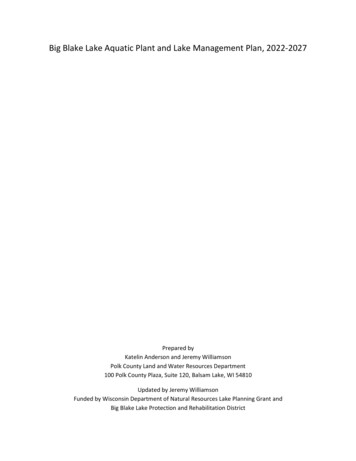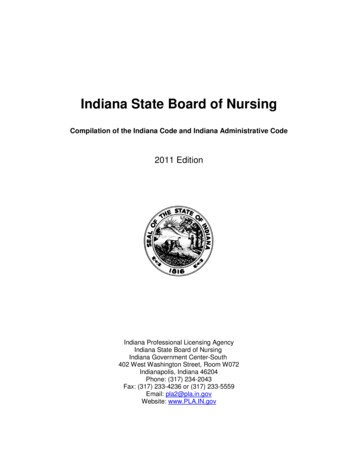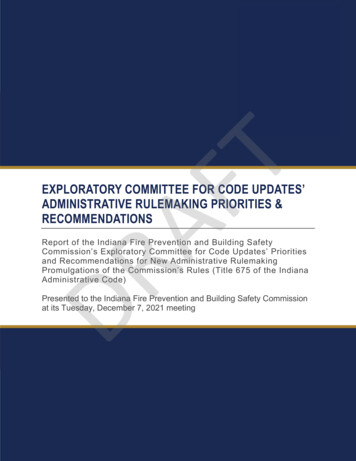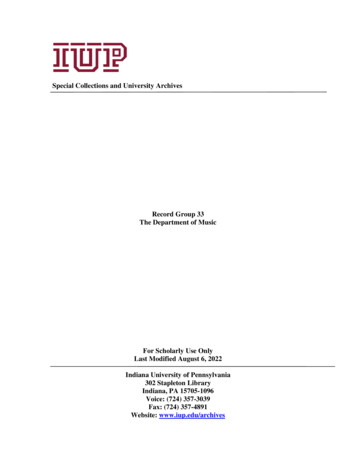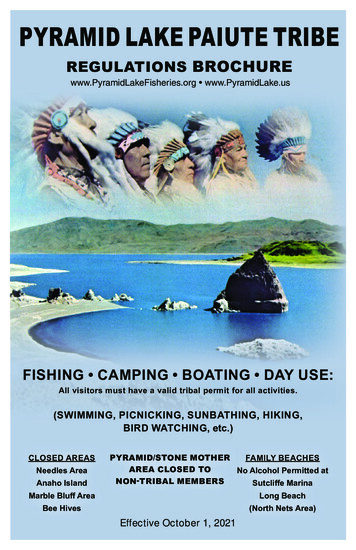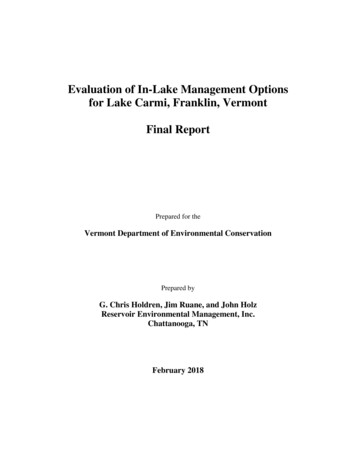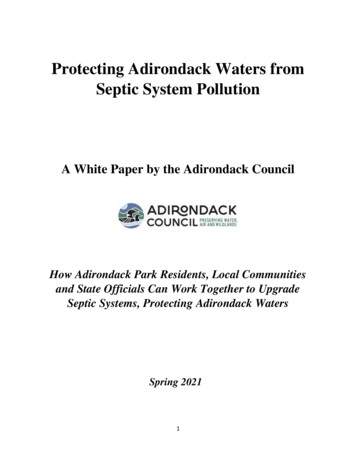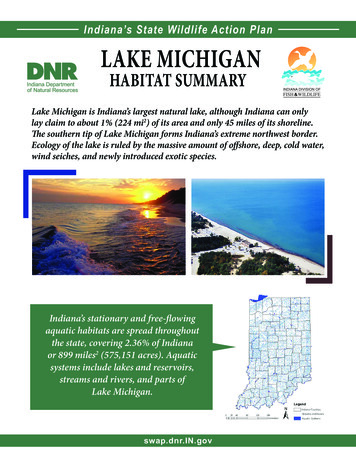
Transcription
1Indiana’s State Wildlife Action PlanLAKE MICHIGANHABITAT SUMMARYLake Michigan is Indiana’s largest natural lake, although Indiana can onlylay claim to about 1% (224 mi2) of its area and only 45 miles of its shoreline.The southern tip of Lake Michigan forms Indiana’s extreme northwest border.Ecology of the lake is ruled by the massive amount of offshore, deep, cold water,wind seiches, and newly introduced exotic species.Indiana’s stationary and free-flowingaquatic habitats are spread throughoutthe state, covering 2.36% of Indianaor 899 miles2 (575,151 acres). Aquaticsystems include lakes and reservoirs,streams and rivers, and parts ofLake Michigan.swap.dnr.IN.gov
2Indiana’s State Wildlife Action PlanRepresentative Species of Lake MichiganLake Michigan habitat guild is represented by several species.These representative species “paint a reasonable mental picture” of Lake Michigan.Blacknose DaceHornyhead ChubGreater RedhorseNorthern Brook LampreyFrom left to right:Ring-Billed GullSpottail ShinerYellow PerchLake TroutSmallmouth BassMottled SculpinSlippershell MusselMucketRainbowYellow Perch (USFWS), Blacknose Dace (Brian Gratwicke), and Ring-billed Gull.Species of Greatest Conservation Need (SGCN) in Lake MichiganSGCN are animal species whose populations are rare, declining, or vulnerable.Peregrine FalconLake WhitefishFrom left to right:Longnose DaceLongnose SuckerSlimy SculpinTrout-perchPeregrine Falcon, Lake Whitefish (Seb951), and Longnose Sucker (USFWS)swap.dnr.IN.gov
3Indiana’s State Wildlife Action PlanThreats to Lake Michigan Invasive/non-native species Habitat fragmentation Habitat degradation Residual contamination (persistent toxins) Climate change Point source pollution (continuing) Drainage practices (stormwater runoff) Nonpoint source pollution (sedimentation and nutrients)High-Priority Conservation Actions for Lake MichiganArtificial habitat creation (artificial reefs, nesting platforms) Erect and maintain nesting boxes for peregrine falcons at industrial areas along Lake Michigan.Habitat protection through regulation Investigate threats to Lake Michigan aquatic habitat and provide technical assistance toregulatory agencies to encourage regulatory relief from those threats or to develop protectiveregulatory measures.Technical assistance Provide technical assistance to industrial landowners, planning commissions, regulatory agenciesand others responsible for land management, protection or remediation on the shore and nearthe shore area of Lake Michigan for the protection of SGCN.Habitat restoration through regulation Promote the use of drainage maintenance BMPs and the use of native species in the restoration ofthe habitat of the near-shore and Indiana portions of Lake Michigan for the benefit of longnosedace, slimy sculpin and trout-perch populations.Land use planning Provide technical assistance to city, county and regional planners and others regarding theecological needs and requirements of SGCN in the Lake Michigan area to promote theconservation of SGCN.Pollution reduction Reduce contaminant loads in birds fed upon by resident and migratory peregrine falcons alongLake Michigan. Encourage avian control operators to use methods that will minimize secondarypoisoning threats to peregrine falcons and other raptors.Adaptive Management Modify survey and monitoring, research, and other conservation actions and activities inresponse to new information to improve habitat conservation efficiency for SGCN.swap.dnr.IN.gov
4Indiana’s State Wildlife Action PlanThreats to SGCN in Lake Michigan Invasive/non-native speciesViable reproductive population size or availabilitySpecialized reproductive behavior or low reproductive ratesPredators (native or domesticated)Dependence on irregular resources (cyclical annual variations) (e.g., food, water, habitatlimited due to annual variations in availability)Bioaccumulation of contaminantsDiseases/parasites (of the species itself)Unintentional take/ direct mortality (e.g., vehicle collisions, power-line collisions, by catch,harvesting equipment, land preparation machinery)Habitat loss (breeding range)Habitat loss (feeding/foraging areas)High-Priority Conservation Actions for SGCN in Lake MichiganHabitat protection Cooperate with all local land owners, land trust and government agencies to secure (acquisition,easements, and cooperate agreements) to protect habitat in and on the near shore of the Indianaportion of Lake Michigan.Population management Investigate and employ as appropriate all animal and plant population management (i.e., deerhunting, exotic control, etc.) techniques that promote the maintenance of native biologicaldiversity in and on the near shore of the Indiana portion of Lake Michigan.Threats reduction Investigate threats and limiting factors affecting SGCN in and on the near shore of the Indianaportion of Lake Michigan.Regulation of collecting Examine reports submitted by holders of the state’s Scientific Purposes License to detectchanges in the distribution of lake whitefish, longnose dace, longnose sucker, slimy sculpin andtrout perch. Adjust limits and capture techniques as warranted to protect SGCN.Public education to reduce human disturbance Make site managers aware of peregrine falcon nesting needs and breeding timelines andencourage adaptive measures to support falcon nest success.swap.dnr.IN.gov
5Indiana’s State Wildlife Action PlanPopulation enhancement (captive breeding and release) Cooperate with Lake Michigan and Great Lake’s fishery initiatives that promote a healthy Lake Michiganecosystem, including self-sustaining populations of all native species.Disease/parasite management Support efforts to prevent the release of exotic pathogens and parasites from international shipping. Provide technical assistance to the public and community leaders regarding all aspects of disease/parasiteintroduction, spread and control to foster the support of an informed citizenry.Limiting contact with pollutants/contaminants Promote and support programs that limit pollution/contaminants release and remediate contaminatedareas impacting Lake Michigan to enhance lake whitefish and longnose sucker populations. Support programs to reduce contaminant loads in birds fed upon by resident and migratory peregrinefalcons along Lake Michigan. Encourage avian control operators to use methods that will minimizesecondary poisoning threats to peregrine falcons and other raptors.Stocking Support evaluation of all intentional and unintentional plant and animal stockings in Lake Michigan todetermine the impact on native biological diversity and the maintenance of self-sustaining populationsof native species.Adaptive Management Modify survey and monitoring, research, and other conservation actions and activities in response tonew information to improve conservation efficiency for SGCN.swap.dnr.IN.gov
LAKE MICHIGAN Lake Michigan is Indiana's largest natural lake, although Indiana can only lay claim to about 1% (224 mi2) of its area and only 45 miles of its shoreline. The southern tip of Lake Michigan forms Indiana's extreme northwest border. Ecology of the lake is ruled by the massive amount of offshore, deep, cold water,
